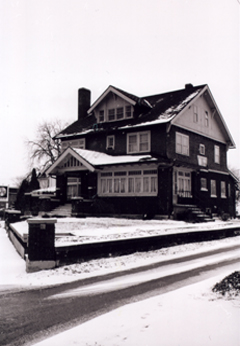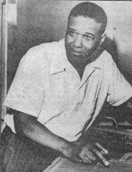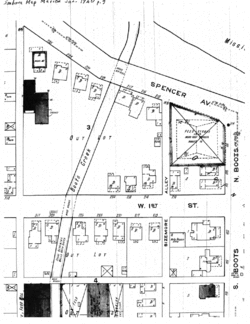Difference between revisions of "225 West Spencer"
(→Construction by the Brubakers) |
(→The Architect, Samuel Plato) |
||
| (One intermediate revision by the same user not shown) | |||
| Line 11: | Line 11: | ||
==The Architect, Samuel Plato== | ==The Architect, Samuel Plato== | ||
| − | Born 1882 in Waugh, Alabama Samuel M. Plato learned carpentry from his father, James. Plato’s father, a former slave learned these skills from being an apprentice of Samuel Carter, a famous enslaved black artisan. At a young age Plato made furniture however when attended State University Normal School in Louisville (later Simmons Bible College) in 1900 he decided to study law. Using his carpentry skills to pay his way through college, Plato graduated from Simmons in 1902 in which he moved to Marion, Indiana. (Edelen Cheryl 2003) It was said that he moved there because the gas economy was booming providing flowing money to build houses and other buildings.(MPL) One of his first be carpentry projects was building a cottage at Fern Creek for the school’s president, Charles L. Purce. | + | [[image:SamuelPlato.jpg|thumb|250px|Samuel Plato]]Born 1882 in Waugh, Alabama Samuel M. Plato learned carpentry from his father, James. Plato’s father, a former slave learned these skills from being an apprentice of Samuel Carter, a famous enslaved black artisan. At a young age Plato made furniture however when attended State University Normal School in Louisville (later Simmons Bible College) in 1900 he decided to study law. Using his carpentry skills to pay his way through college, Plato graduated from Simmons in 1902 in which he moved to Marion, Indiana. (Edelen Cheryl 2003) It was said that he moved there because the gas economy was booming providing flowing money to build houses and other buildings.(MPL) One of his first be carpentry projects was building a cottage at Fern Creek for the school’s president, Charles L. Purce. |
Plato learned architecture through a program from the International Correspondence School. He was one of the first African American architects to be awarded a contract to build a post office. Although Samuel called Louisville his home for most of his life, Plato traveled all over doing architectural jobs. He built over 39 post offices all over the United States of America, Plato also designed mansions, banks, churches, schools, office buildings and theaters. Several of Plato’s projects in Kentucky and Indiana have been named historical sites. | Plato learned architecture through a program from the International Correspondence School. He was one of the first African American architects to be awarded a contract to build a post office. Although Samuel called Louisville his home for most of his life, Plato traveled all over doing architectural jobs. He built over 39 post offices all over the United States of America, Plato also designed mansions, banks, churches, schools, office buildings and theaters. Several of Plato’s projects in Kentucky and Indiana have been named historical sites. | ||
| Line 23: | Line 23: | ||
==Construction by the Brubakers== | ==Construction by the Brubakers== | ||
| − | [[image:225_Spencer_Sanborn_Map.gif|thumb| | + | [[image:225_Spencer_Sanborn_Map.gif|thumb|250px|The 1920 Sanborn Map of Marion, showing the house at 225 Spencer in the upper-left corner]]The land circulated for nearly 80 years before the construction of the house. Elisabeth S. King sold the property to William Brubaker on July 10, 1902. When interviewed, Sue Wagaman, current owner of the house, said the building was constructed in 1906. However, looking at a Sanborn Map of Marion from 1911, 225 Spencer Avenue is not shown. Perhaps it was cut off in the corner, but 223 to 215 are all shown. The 1920 Sanborn Map, however, does show 225. The abstract of the house shows that the Brubaker’s were the first owners of the house, and bought the property in 1902. |
Looking at the city directory, Mary and William are said to live at 223 West Spencer until 1913, when they are shown to be living at 104 Wabash Avenue. Then, in 1915 the city directory shows there home at 225 West Spencer. Since the Brubakers owned the property since 1902, it is hard to say why the city directory has them at three different locations before they sold the house in 1927.Putting all the research together, it is unclear why the house is not shown on the map until much later, but can be concluded that the house was built in the early 1900’s. | Looking at the city directory, Mary and William are said to live at 223 West Spencer until 1913, when they are shown to be living at 104 Wabash Avenue. Then, in 1915 the city directory shows there home at 225 West Spencer. Since the Brubakers owned the property since 1902, it is hard to say why the city directory has them at three different locations before they sold the house in 1927.Putting all the research together, it is unclear why the house is not shown on the map until much later, but can be concluded that the house was built in the early 1900’s. | ||
| Line 34: | Line 34: | ||
The abstract stops with the sale of the house from Julian Savesky to William R. Kean in 1967. The city directories of 1968 and 1969 show that the house was vacant in both years, and then bought by Paul M. Nahler and his wife Joanne in 1970. Apparently the house was also being rented by James M. Nahler as well, and this could be the time when the house was a duplex. Under 225 West Spencer Avenue in the 1971-1972 city directory all that is listed is the words, “No return,” so it is unclear who lived in the house at that time. | The abstract stops with the sale of the house from Julian Savesky to William R. Kean in 1967. The city directories of 1968 and 1969 show that the house was vacant in both years, and then bought by Paul M. Nahler and his wife Joanne in 1970. Apparently the house was also being rented by James M. Nahler as well, and this could be the time when the house was a duplex. Under 225 West Spencer Avenue in the 1971-1972 city directory all that is listed is the words, “No return,” so it is unclear who lived in the house at that time. | ||
| − | In 1973, Otis Williams and his wife Georgia purchased the house from Nahier, and lived there until 1995. Otis died in June of 1995, and Georgia died just one year later in June of 1996. Again, the city directory does not list 225 West Spencer Avenue at all during the period of 1997-1998. | + | [[image:Aunt_Sue's_Tea_Room.jpg|thumb|left]]In 1973, Otis Williams and his wife Georgia purchased the house from Nahier, and lived there until 1995. Otis died in June of 1995, and Georgia died just one year later in June of 1996. Again, the city directory does not list 225 West Spencer Avenue at all during the period of 1997-1998. |
In 1999, Casey Lloyd, owner of the Casey Lloyd Funeral Home, bought the house. Three years later, Patricia G. Hagland and her husband Neil A. bought the house, then sold it to business management consultant Pamela Schlechty in 2003 (City Directory). Sue and Randy Wagaman then purchased the Tea Room in 2004, and it opened in mid-April of this year. | In 1999, Casey Lloyd, owner of the Casey Lloyd Funeral Home, bought the house. Three years later, Patricia G. Hagland and her husband Neil A. bought the house, then sold it to business management consultant Pamela Schlechty in 2003 (City Directory). Sue and Randy Wagaman then purchased the Tea Room in 2004, and it opened in mid-April of this year. | ||
Latest revision as of 22:32, 1 April 2007
The house currently at 225 West Spencer Avenue in Marion, Indiana is one of the several historical houses designed by the famous African-American architect Samuel Plato. This house has served as not only a home for several families, but also for use as a funeral home. Today, it is known as Aunt Sue’s Tea Room. Since its construction in 1906, this three-story home has been used for many purposes and has seen many people come and go. Its history and character lie in its physical structure, its architect, and the past owners.Contents
The Physical Structure
The house itself has held up incredibly well for being nearly one hundred years old. Some of the original glass can still be seen in the sun room windows. Excluding a few minor scratches in the floor or dents here and there, the house has been well taken care of. Much of the original building is still intact, including original rippled class in the sun room, stained glass windows and doors, wood moldings, and a dark wood buffet (see attached photographs).Sue Wagaman said that there has been some remodeling done to the house, as is to be expected. A new kitchen was created for the business and one room’s floor had to be redone due to irreparable damage. While remodeling the walls, Sue’s husband Randy found an empty whiskey bottle, among other things, tucked inside the wall with a tax stamp dating around 1910. The fireplace is a newer style, possibly from the 1920’s or 3 0’s. Sue stated that there might have been a fire in the third floor at some point, although no information could be found on the subject. The house also used to be a duplex at one point, so at some time the dividing features between the two halves were torn down. Again, no more information could be found on the subject. Other than some slight reconstruction work to keep the house in working order, the building remains beautiful and retains its original character.
Due to the high quality of craftsmanship and authentic use of various styles, Plato’s projects displayed historical value. Styles such as Bungalow, Mediterranean, and Greek-revival were all tied together with excellent craftsmanship and carpentry to form Plato masterpieces. (Blunk David II) The house on 225 W. Spencer is a two story single family residence primarily in the Arts and Crafts style.
Platonian windows are the most significant trademark of his projects. Uncomplicated yet stunning original glass and casings still remain reside in most of the houses today. Applying the trade in which he learned from his father, Plato constructed cabinets, doors and windows making his architecture even more unique.
The Architect, Samuel Plato
Born 1882 in Waugh, Alabama Samuel M. Plato learned carpentry from his father, James. Plato’s father, a former slave learned these skills from being an apprentice of Samuel Carter, a famous enslaved black artisan. At a young age Plato made furniture however when attended State University Normal School in Louisville (later Simmons Bible College) in 1900 he decided to study law. Using his carpentry skills to pay his way through college, Plato graduated from Simmons in 1902 in which he moved to Marion, Indiana. (Edelen Cheryl 2003) It was said that he moved there because the gas economy was booming providing flowing money to build houses and other buildings.(MPL) One of his first be carpentry projects was building a cottage at Fern Creek for the school’s president, Charles L. Purce.Plato learned architecture through a program from the International Correspondence School. He was one of the first African American architects to be awarded a contract to build a post office. Although Samuel called Louisville his home for most of his life, Plato traveled all over doing architectural jobs. He built over 39 post offices all over the United States of America, Plato also designed mansions, banks, churches, schools, office buildings and theaters. Several of Plato’s projects in Kentucky and Indiana have been named historical sites.
Plato worked extremely hard to be recognized and accepted by other architects, contractors and wealthy people. He often used family and friend connections in order to get work kept all business within his own people, hiring African-American whenever possible. His first wife's father, Thaddeus S. Lusby Sr., was a successful carpenter and builder. His second wife Elnora, often served as his business manager and would use money earned from her dress-making business during money droughts. (Edelen Cheryl 2003) Samuel Plato died in 1957 at the age of 75 years.
Samuel Plato and his work has and continues to be contribute to the advancement of the community, especially those whom are African American. “…he breaks a stereotype of what people think {African-American} men do. He represents a success story in the field of architecture. A lot of success stories you hear about {African-Americans) stress sports. That isn’t always so.” (Green Earl)
The Lot
The land where the Tea Room now sits was originally part of a nearly 107 acre plot of land granted to Martin Boots in 1826 (Abstract). Granted to Boots by John Quincy Adams, and dated the first of May, this large parcel of land was quickly divided and sold to numerous families. The abstract shows that Martin Boots first gave Riley Marshall 30 acres of the land, who in turn gave it to others. Many people owned the land, including a Mr. David R. McKinney, Jr. who had the land repossessed after his failure to pay back his $1,218.18 loan (Abstract).
Construction by the Brubakers
The land circulated for nearly 80 years before the construction of the house. Elisabeth S. King sold the property to William Brubaker on July 10, 1902. When interviewed, Sue Wagaman, current owner of the house, said the building was constructed in 1906. However, looking at a Sanborn Map of Marion from 1911, 225 Spencer Avenue is not shown. Perhaps it was cut off in the corner, but 223 to 215 are all shown. The 1920 Sanborn Map, however, does show 225. The abstract of the house shows that the Brubaker’s were the first owners of the house, and bought the property in 1902.Looking at the city directory, Mary and William are said to live at 223 West Spencer until 1913, when they are shown to be living at 104 Wabash Avenue. Then, in 1915 the city directory shows there home at 225 West Spencer. Since the Brubakers owned the property since 1902, it is hard to say why the city directory has them at three different locations before they sold the house in 1927.Putting all the research together, it is unclear why the house is not shown on the map until much later, but can be concluded that the house was built in the early 1900’s.
The Brubakers, William and Mary, lived in the house for many years, paying off their mortgage in 1927 (Abstract). William owned a furniture store in Marion for several years that sold stoves, carpets, and home furnishings (City Directory 1912). William Brubaker lived to be ninety years-old, though he spent the last part of his life in Missouri (Brubaker Funeral Rites).
Later Owners
After the Brubakers, the Saveskys, Myer and Sadie, owned the house. Myer Savesky owned a business with his brother, Mark B. Savesky, in 1929, but is shown to be the secretary-treasurer of Grant Iron and Metals Incorporated in 1930 (City Directory 1929, 1930). His obituary, however, says that he was the owner and operator of Grant Iron and Metals, Inc. Sadie Savesky died July 16th, 1932, leaving the property to Meyer and his son Julian (Abstract). Meyer remarried with second wife Ceilia Frank in 1936. The 1935-1938 city directories also state that a student by the name of Jerome H. Savesky was renting the house during that time, though he is never mentioned in the abstract or Meyer’s obituary. When Meyer died on May 22, 1951 from an extended illness (Leader-Tribune), Ceilia was granted the property in the will. She then died (the date is unknown) and left the house to Meyer’s son Julian, while leaving other properties of hers to other relatives (Abstract).
The abstract stops with the sale of the house from Julian Savesky to William R. Kean in 1967. The city directories of 1968 and 1969 show that the house was vacant in both years, and then bought by Paul M. Nahler and his wife Joanne in 1970. Apparently the house was also being rented by James M. Nahler as well, and this could be the time when the house was a duplex. Under 225 West Spencer Avenue in the 1971-1972 city directory all that is listed is the words, “No return,” so it is unclear who lived in the house at that time.
In 1973, Otis Williams and his wife Georgia purchased the house from Nahier, and lived there until 1995. Otis died in June of 1995, and Georgia died just one year later in June of 1996. Again, the city directory does not list 225 West Spencer Avenue at all during the period of 1997-1998.In 1999, Casey Lloyd, owner of the Casey Lloyd Funeral Home, bought the house. Three years later, Patricia G. Hagland and her husband Neil A. bought the house, then sold it to business management consultant Pamela Schlechty in 2003 (City Directory). Sue and Randy Wagaman then purchased the Tea Room in 2004, and it opened in mid-April of this year.
Conclusion
The house that started with the Brubakers has seen its character develop through its actual structure, its architect, and its inhabitants. Over the span of a hundred years, the house located at 225 West Spencer Avenue has become part of Marion’s quiet history. The doors of the house do not just open to a Tea Room, but also to years past and decades gone by.
Works Cited
- Abstract for 225 West Spencer Avenue. King’s Title and Abstract.
- “Brubaker Funeral Rites are Pending in Wabash.” The Leader-Tribune. 14 December 1946.
- Grant County Interim Report. March 1993.
- “Meyer Savesky.” The Leader-Tribune. 23 May 1951.
- Neher, Leslie I. Samuel M Plato: His buildings and the people that use them.
- Polk’s Marion City Directory (1911-2003). Indianapolis: R.L. Polk and Company.
- Sanborn Map of Marion. January 1920.
- Sanborn Map of Marion. October 1911.
- Wagaman, Sue. 13 May 2005.
Credits
This article is a combination of two papers written by students. Natasha Kay Kroma wrote one paper during Winter 2003, and Jamie Pearson wrote another in Spring 2005. Both were submitted for Mr. Munn's AP US History class at Marion High School.




